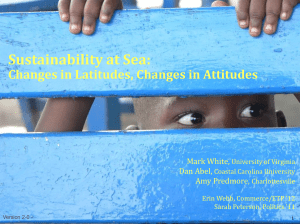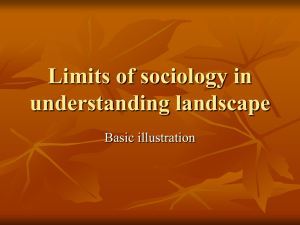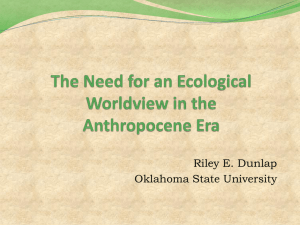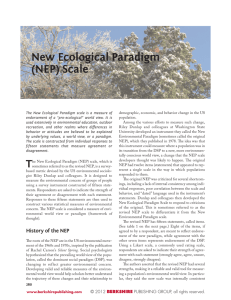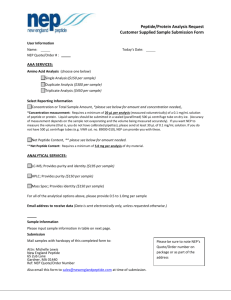Measuring the level of endorsement of the New
advertisement
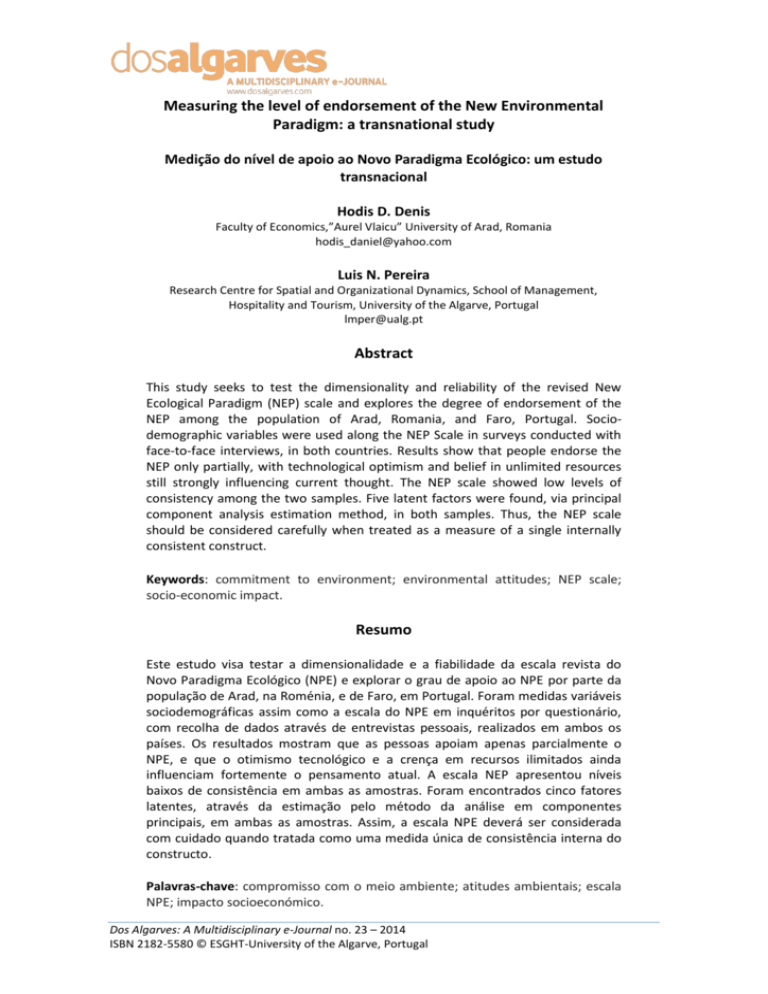
Measuring the level of endorsement of the New Environmental Paradigm: a transnational study Medição do nível de apoio ao Novo Paradigma Ecológico: um estudo transnacional Hodis D. Denis Faculty of Economics,”Aurel Vlaicu” University of Arad, Romania hodis_daniel@yahoo.com Luis N. Pereira Research Centre for Spatial and Organizational Dynamics, School of Management, Hospitality and Tourism, University of the Algarve, Portugal lmper@ualg.pt Abstract This study seeks to test the dimensionality and reliability of the revised New Ecological Paradigm (NEP) scale and explores the degree of endorsement of the NEP among the population of Arad, Romania, and Faro, Portugal. Sociodemographic variables were used along the NEP Scale in surveys conducted with face-to-face interviews, in both countries. Results show that people endorse the NEP only partially, with technological optimism and belief in unlimited resources still strongly influencing current thought. The NEP scale showed low levels of consistency among the two samples. Five latent factors were found, via principal component analysis estimation method, in both samples. Thus, the NEP scale should be considered carefully when treated as a measure of a single internally consistent construct. Keywords: commitment to environment; environmental attitudes; NEP scale; socio-economic impact. Resumo Este estudo visa testar a dimensionalidade e a fiabilidade da escala revista do Novo Paradigma Ecológico (NPE) e explorar o grau de apoio ao NPE por parte da população de Arad, na Roménia, e de Faro, em Portugal. Foram medidas variáveis sociodemográficas assim como a escala do NPE em inquéritos por questionário, com recolha de dados através de entrevistas pessoais, realizados em ambos os países. Os resultados mostram que as pessoas apoiam apenas parcialmente o NPE, e que o otimismo tecnológico e a crença em recursos ilimitados ainda influenciam fortemente o pensamento atual. A escala NEP apresentou níveis baixos de consistência em ambas as amostras. Foram encontrados cinco fatores latentes, através da estimação pelo método da análise em componentes principais, em ambas as amostras. Assim, a escala NPE deverá ser considerada com cuidado quando tratada como uma medida única de consistência interna do constructo. Palavras-chave: compromisso com o meio ambiente; atitudes ambientais; escala NPE; impacto socioeconómico. Dos Algarves: A Multidisciplinary e-Journal no. 23 – 2014 ISBN 2182-5580 © ESGHT-University of the Algarve, Portugal Hodis Denis ● Luis Pereira 1. Introduction Growing into a multifaceted and complex public topic with instant and widespread recognition given by the media, “Earth Day 1970” is often referred to as the first day of modern environmentalism (Hannigan, 2006). Science communicators like Barry Commoner, Garrett Hardin, Paul Ehrlich and Rachel Carson brought to the attention of a large audience issues related to dangers of pesticide misuse, overpopulation, nuclear threats, urban smog and other such concerns. The “magnifying glass” effect of the mass media and NGOs reinforced the reality of these issues forcing both people and institutions to reconsider their impact on the natural environment. Treating the environment as a social construct and thus an object of people’s attitudes, several researchers have engaged in creating environmental attitude scales. Among the most well known are Maloney and Ward’s Ecology Scale - 1973, Weigel and Weigel’s Environmental Concern Scale - 1978 and Dunlap and Van Liere’s New Environmental Paradigm (NEP) Scale – 1978, which represents the focus of this paper (Milfont, 2009). Dunlap et al. (2000) argued that implicit within environmentalism was a challenge to our fundamental views about nature and people’s relationship to it. The Ecology Scale and the Environmental Concern Scale probe a range of domains of environmental attitude which reflect dominant and specific issues at the time of their construction (such as air pollution, water pollution, loss of aesthetic values and energy conservation), thus contrasting the NEP scale which aimed to distinguish people’s distinctive world views based on beliefs about the rights and responsibilities of humans in relation to the rest of nature, avoiding reference to specific environmental issues (Alcock, 2012). This study seeks to test the dimensionality and reliability of the revised NEP scale and explores the degree of endorsement of the NEP among the population of Arad, Romania and Faro, Portugal. These countries were selected in order to compare the level of endorsement of the NEP in countries in the east and west of Europe. In order to understand recent developments in public support for environmental politics on the domestic and the international level, we have to investigate whether and how individuals think, feel, and act on issues which are related to the environment (Schaffrin, 2011). Environmental concern is defined by Dunlap & Jones (2002: 482-490) 5| Dos Algarves: A Multidisciplinary e-Journal no.23 - 2014 as indicating “the degree to which people are aware of problems regarding the environment and support efforts to solve them and or indicate the willingness to contribute personally to their solution”. The background of the NEP Scale is based on a continuous dichotomy between what Pirages & Ehrlich (1974: 27) coined as the Dominant Social Paradigm (DSP) and, what Dunlap and Van Liere coined the New Environmental Paradigm (later converted to New Ecological Paradigm). An excellent illustration of the evolution of the DSP-NEP dichotomy was carried out by Thomson et al. (2013). This continuum of different ecological viewpoints progresses from an anti-ecological paradigm to a “shallow\light” ecological paradigm through a “middle green” ecological paradigm (Dunlap and Van Liere’s New Environmental and New Ecological Paradigm) and ends with a “deep green” ecological paradigm advocated by Naess (1973). The “deep green” ecological paradigm is presented only so that the full spectrum of degrees of environmental concern is explained; the exploration of such a degree of environmental concern not pertaining to the scope of this paper. Schaffrin (2011) notes that recent research argues for the multidimensional character of environmental concern, having both a horizontal dimension (cognitive, conative) and a vertical dimension (which includes people’s motivations for their concern). Therefore, the development of an internally consistent scale measuring the dimensions shaping people’s environmental concern is of great importance. 1.1 The anthropocentric worldview (1970’s dominant social paradigm) This worldview is considered to have an anti-environmental thrust. Those who view the world in this way live under the presumptions that human beings are separated from nature, that humans are more worthy than other organisms, that humans are unique due to the use of language, logical reasoning and advanced tools when building our societies, that humans are morally superior compared with nonhumans, that humans are in control of nature’s resources (which we see as a huge robust warehouse of resources that humans are entitled to use to increase their wealth and well-being, both in material and aesthetic terms), that humans are rightfully allowed to subdue nature, that humans are willing to grant intrinsic value |6 Hodis Denis ● Luis Pereira (and rights and interests) to human-beings in order to dominate other forms of life and that our acts towards nature are judged on how they affect us, not on how they affect other human beings (Lundmark, 2007). Under this paradigm, the world is seen as having unlimited resources rendering the conservation of the natural environment without much use, conservation efforts being employed only for those parts of the environment which have utilitarian values for humans. Considering ourselves exempt from environmental constraints we feed our optimism from the use of science and technology to submit nature to our will and find solutions to any problems that occur so that our striving for continuous abundance and prosperity achieved through progress and economic growth will, hopefully, never cease (Lundmark, 2007). The anthropocentric orientation of the DSP comes from the way of thinking most appreciated in the Enlightenment period of the 17th and 18th centuries and from the Judeo-Christian cosmology of the Western world. Thus it is that liberal economy, individual atomism, material abundance, institutionalized economic growth and private property rights represent the foundation of our society. This frame of social arrangement pushes individuals, companies and institutions to act egoistically, assessing costs and benefits of activities in terms of personal selves (Lundmark, 2007). 1.2 Sustainable development This paradigm proposes that humans must admit that they are reliant on natural resources for survival and wellbeing, that they are sensitive to risks arising from our reliance on and relationship with nature (including the risk of irreversible resource depletion) and that environmental protection is due mainly to anthropocentric altruism, with degradation of the environment also leading to the degradation of humans’ wellbeing. Sustainable development sees the good health of the environment as instrumental in ensuring human wellbeing. World peace and equality is another trend in this paradigm because wellbeing is judged on the costs and benefits to humans as a group or as individuals in general (Thomson, 2013). 7| Dos Algarves: A Multidisciplinary e-Journal no.23 - 2014 1.3 The new environmental paradigm (shallow or light ecological awareness) This paradigm represents a mixture of values between the DSP and eco-centrism, focusing on the importance of the natural environment for the health and wellbeing of humans, on the health of the environment, opposition to over-exploitation of natural resources and on political measures that deal with environmental issues. Adopting this world view, humans recognize nature’s delicate balance and the possibility of facing severe environmental problems due to excessive human interference (Thomson, 2013). The main concern of this paradigm is the welfare of humans rather than embracing non-human life forms and ecosystems. In the light of this way of thinking humans need to uphold nature’s balance, to admit the existence of limits to human societies’ growth and adapt to these limits, to consider the possibility of steady state economies, to adopt consultative and participatory politics that emphasize foresight and careful planning in order to avoid risks to humans and nature and to seek to change society towards cooperation, openness and participation (Thomson, 2013). In a “shallow/light green” worldview a hierarchy as to what is considered to have intrinsic value sees mammals as the most valuable, followed by sentient beings where the ecosystem only needs protection because it provides habitat for these sentient beings, followed by all recognized life such as plants and animals, followed by the habitats of all plants and animals followed by the rest. In addition, there is an issue as to whether we have a generalized compassion toward other species, other people, and other generations (Thomson, 2013). This paradigm fails to ask deep questions about ecological relationships and the origins of environmental problems; it also lacks a consistent understanding of sustainability and social justice, the recommendations it makes leaving the structure of advanced society unchanged (Lundmark, 2007). 1.4 The new ecological paradigm (“middle green” ecological awareness) The difference between the “shallow/light green” and “middle green” environmentalism, according to Thomson (2013), is one of nuance, the latter also |8 Hodis Denis ● Luis Pereira admitting equal rights to existence to both human and non-human species (plants and animals) (augmenting the emphasis on the protection and conservation of plants, animals and their environments). Also, “middle green” environmentalism adds the possibility of an ecological crisis affecting our society if we do not act in this direction. Thus, this type of ecological awareness goes beyond “shallow/light” environmentalism through acknowledgement of the risk of an ecological crisis and rejection of human exemptionalism from nature. 1.5 The eco-centric paradigm (“deep green” ecological awareness) This paradigm considers that individual living organisms, species and entire biotic communities possess intrinsic value, that humans and nature are intimately interconnected (including our mutual long term interests and welfare), that the natural environment consists of complex webs of ecological interdependence, that our interconnectedness provides the basis for a new sense of empathy and caution (relieving us from the notion that we are exempt from nature), that we along with other species and ecosystems are likely to be affected by an ecological crisis resulting from our ongoing action, that we have to appreciate more the unforeseen consequences of human intervention (such as pollution and other forms of human intervention) which can have multiple and highly elusive ecological effects and that the environmental crisis is the effect of an inflated sense of human self-importance and misconceived beliefs in our capacity to understand biospherical processes (Thomson, 2013). This paradigm asks humans to believe in the perception of wholeness, in the intrinsic value of human and non-human individuals and species, collectivities of species and eco-systems, in the possibility to defend nature’s integrity by seeing ourselves as part of nature and in promoting holistic methods of environmental conservation. It has a deep emotional concern about the future of the environment, high standards of moral human-nature relationships and a skeptical view to human’s capacity of dealing with environmental problems. It applies across species boundaries, geographical boundaries and time boundaries (Thomson, 2013). 9| Dos Algarves: A Multidisciplinary e-Journal no.23 - 2014 In regards to the social discourse, matters such as biotic rights, intrinsic value of nature and humans’ moral obligations towards future organisms must be included. A reflection of this concern can be observed in specific attitudes and personal norms, a greater care for the surrounding environment in cost-benefit analyses of human activities and a reconsideration of major political, economic and social systems (Thomson, 2013). 2. Methodology 2.1 The NEP scale The NEP scale tries to identify the way people understand nature and the way they see their relationship with nature. The questionnaire used for this study is borrowed from the study carried out by Dunlap et al. (2000). It is composed of 15 NEP items and seven socio-demographic items. The first NEP scale was focused on beliefs about the fragility of nature’s balance, limits to growth of human societies and anthropocentrism. The set of 12 Likert items of the first NEP scale exhibited a good deal of internal consistency strongly discriminating between known environmentalists and the general public (Dunlap et al., 2000). The revised version included two new dimensions: “human exemptionalism” and “the possibility of an eco-crisis”, thus addressing broader phenomena like climate change. Specifically, Dunlap et al. (2000) adjusted the phrasing of items on the scale to reduce outdated and biased language, balanced the number of pro versus anti-NEP items, and employed the concept of “facets” in an attempt to clarify and strengthen the content validity of the measure (Amburgey & Thoman, 2012). Anderson (2012) points out three broad categories of criticisms brought to the NEP Scale, as follows: one arising from supposedly missing certain elements of a proecological worldview such as expressions of bio-centric or eco-centric worldview, one from scale validity of the nature of the “value-action gap” and one from the dimensionality of the revised NEP scale. Erdogan (2009) and Dunlap et al. (2000) note that several studies employing the NEP scale resulted in differing numbers of dimensions, ranging from two to five dimensions, thus making the dimensionality and | 10 Hodis Denis ● Luis Pereira validity across different societies of the scale questionable. These results justify this research in countries where the NEP scale had never been used. Finally, it is important to note that the NEP scale used by Dunlap et al. (2000) was translated into Portuguese and Romanian and then translated back to ensure accuracy, without any modification to content or meaning. The survey was conducted via personal interviews by one of the authors of this research. 2.2 Study population and sample The population of this study is made up of the citizens of Faro (Portugal) and Arad (Romania). The target population of the study represents citizens, male and female, that are over 15 years of age (before the following dates: Faro – January 2012 and Arad – March 2012). The target population is divided into six groups by age and gender. Age groups were chosen in order to compare the environmental attitudes of young people (15 – 25 yo), working age people (26 – 64 yo) and the elderly (65+ yo). For this research the method of stratified sampling was chosen because it can convey a high precision level whilst requiring low financial, material and temporal resources. Furthermore, this method assures that specific subpopulations (according to age and gender) are represented in the sample. The city of Faro was included in this study (besides Arad) because the first author of this paper earned an Erasmus scholarship to the University of Algarve in the winter session of the 2011 – 2012 school year. This mobility to Portugal made possible the comparison of the worldviews of two cities from countries with different backgrounds. Proportional stratified sampling was employed using the mean as a parameter of interest. The relative sample error admitted in each stratum was set at 2.5% and a confidence level of 96% was used both in Faro and Arad. The variable of interest used has a 5-point Likert Scale. After applying proportionate stratified sampling, the resulting samples were of 119 citizens in Faro and 205 citizens in Arad. The allocation of the samples of each country to their strata is presented in Table 1. 11| Dos Algarves: A Multidisciplinary e-Journal no.23 - 2014 Table 1: Population and sample of the study Arad Age Male Faro Female Male Female TP SP TP SP TP SP TP SP 9,954 14 10,099 14 2,874 7 2,870 7 15-24 yo 47,435 68 53,479 77 16,233 39 17,239 42 25-64 yo 8,483 12 13,864 20 4,181 10 5,680 14 65+ yo TP – Total Population >15yo (According to CJS Arad, the County Statistical Center, – by the 1st of January 2011– and INE Portugal, the National Statistical Institute – by the 7th of June 2011); SP – Sample 2.3 Measurement and analysis In the data analysis mostly univariate analyses were used, but also some bivariate and multivariate analysis was carried out. The statistical treatment of the data was performed using the software Statistical Package for Social Sciences (SPSS) version 20.0. The questionnaire was composed of the 15 statements and five sociodemographic questions regarding: gender, age, education level, marital status and level of income. The central tendency of the sample was determined using mean scores, and item response distribution was determined using frequency analysis. In order to evaluate people’s worldview, an index presenting the overall environmental orientation was calculated by averaging the mean of the scores of the NEP items. These were used only to summarize the results of the two samples and not to test the scale. The internal consistency reliability of the scale was assessed using Cronbach’s alpha. This coefficient does not imply that a scale is unidimensional or multidimensional; a high Cronbach's alpha can be obtained even if a scale is not unidimensional. In order to verify the dimensionality of the scale, factor analysis was employed. An eigenvalue of 1.00 was used for factor identification. Each item was measured using a 5-point Lickert scale. The items that formed the revised NEP scale can be seen in Table 2. Construct validity is examined through non-parametric tests, since distributions of the NEP-scale variables are skewed. However, it was verified that similar results and the same conclusions were obtained if parametric tests were used. Straughan & Roberts (1999) note that there are many studies that explore the relationship between | 12 Hodis Denis ● Luis Pereira gender, age, education level, marital status and level of income and ecology; studies both supporting and opposing the existence of a relationship between these sociodemographic variables and environmental concern. If the NEP scale measures a valid construct, then it should correlate with certain personal characteristics (Hartono, 2008) of environmentalists such as: young, female, well educated, married and with moderate to high income. The five facets of the NEP are the reality of limits to growth of human societies (items 1, 6, and 11), anti-anthropocentrism (items 2, 7 and 12), the fragility of nature's balance (items 3, 8 and 13), the rejection of human exemptionalism (items 4, 9 and 14) and the possibility of an ecological crisis (items 5, 10 and 15). Pro-NEP responses were expected to achieve relatively high scores and DSP responses were expected to achieve relatively low scores. Responses were scored on a 5-point Likert scale ranging from 1 (totally disagree) to 5 (totally agree). Agreement with the eight odd-numbered items indicates pro-NEP orientation. Agreement with the seven even numbered items indicates pro-DSP orientation. In order to facilitate understanding of item sample mean scores, directionality of the seven even numbered items was changed using the formula: reverse score (x) = max(x) + 1 – x, where max(x) is the maximum possible value for x. In our case, max(x) is 5 because the Likert scale only went up to 5. This way all means will have a tendency towards 5. This operation was restricted solely to the data in Tables 2 and 3. 3. Results 3.1 Environmental worldviews The environmental worldviews of the two samples were determined by providing percentage distribution, mean scores and indexes of the samples’ NEP scores (Table 2). The mean score for the 15 items, after correcting for the directionality of the items (that is, pro-NEP views are represented as higher numbers), was found to be 3.39 in Arad and 3.41 in Faro (out of a possible 5) indicating that the overall orientation of samples belongs to the lower rank of the pro-NEP worldview. 13| Dos Algarves: A Multidisciplinary e-Journal no.23 - 2014 In the Romanian sample, the mean scores for eight pro-NEP items range from 3.24 to 4.20, whereas the mean scores for seven DSP items range from 1.64 to 3.30. Frequency distributions on the Pro-NEP items show that three quarters of the sample (74.6%) agreed on these statements, 13.4% were undecided, whereas only 12% disagreed. Conversely, distributions on the pro-DSP items reveal that 49.8% of the sample agreed with the statements, while there are considerable numbers of disagreeing (36.1%) and undecided (14.1%) portions of the sample. The standard deviation in the sample ranged from 0.705 on item 6 to 1.345 on item 2 (see Table 3). In the Portuguese sample, the mean scores for eight pro-NEP items range from 2.83 to 4.45, whereas the mean scores for seven DSP items range from 1.73 to 3.58. Frequency distributions on the Pro-NEP items show that more than three quarters of the sample (77.8%) agreed on these statements, 8.6% were undecided, whereas only 13.6% disagreed. Distributions on the pro-DSP items reveal that a substantial number (50.6%) of the sample agreed with the statements, while 35.9% disagreed and 13.4% were undecided. The standard deviation in the sample ranged from 0.512 on item 5 to 1.221 on item 12 (see Table 3). Examining the overall frequency and mean distributions reveals that majorities of the two samples support the NEP statements to varying degree, but there is no widespread support for a pro-NEP view in general. Findings on the statements are as follows: Limits to growth (Arad): An examination of this dimension reveals that 45.4% of the sample embrace beliefs about population control (item 1), strongly (12.2%) and mildly (33.2%), 25.3% oppose these beliefs and 29.3% have irresolute views. Regarding the limits to human interference with nature (item 11) almost three quarters of the sample (71.2%), strongly (19.5%) and mildly (51.7%) held pro-NEP views, 13.6% disagreed and 15.6% had ambivalent views. However, most of the sample (94.7%) accepted the DSP idea of unlimited resources and learning to use them (item 6), while only 2.5% disagreed and 2.9% had irresolute views. Limits to growth (Faro): 42.0% of the sample embrace beliefs about population control (item 1), strongly (10.9%) and mildly (31.1%), 34.0% oppose these beliefs and 24.4% | 14 Hodis Denis ● Luis Pereira have irresolute views. Regarding the limits to human interference with nature (item 11) slightly over a third of the sample (35.3%) strongly (4.2%) and mildly (31.1%) held pro-NEP views, 46.2% disagreed and 18.5% had irresolute views. However, most of the sample (95%) accepted the DSP idea of unlimited resources and learning to use them (item 6), while only 4.2% disagreed and 0.8% had irresolute views. Thus, the assumption that parts of both samples are less accepting of the NEP valuation of nature and more aligned with the DSP value on economic growth gains weight. Anti-anthropocentrism (Arad): A pro-NEP worldview does not accept the idea that nature exists primarily for human use and has no inherent value of its own (item 12), and that humans have the right to modify the natural environment to suit their needs (item 2). Over half (52.2%) of the sample (23.9%) strongly and (28.3%) mildly oppose the anthropocentric view put forward by item 2, over a third (36.1%) agree and 11.7% of the sample have irresolute views. On item 12 the sample is quite divided, with 46.4% holding anti-anthropocentric views, while a considerable number (43.4%) hold anthropocentric views and only 10.2% have ambivalent views. The antianthropocentric statement about the right of existence of plants and animals (item 7) is supported by the vast majority (84.9%), being opposed only by 5.4% while 9.8% held ambivalent views. Anti-anthropocentrism (Faro): The anthropocentric view put forward by item 2 was strongly (17.6%) and mildly (40.3%) opposed by 57.9% of the sample, a considerable number (30.3%) agreed and 11.8% of the sample had ambivalent views. Similarly, on item 12 the Portuguese sample is also quite divided, with 39.5% holding antianthropocentric views and a considerable number (45.4%) holding anthropocentric views, while 15.1% have ambivalent views. The statement about the right of existence of plants and animals (item 7) is supported by the vast majority (94.2%), being opposed only by 1.6% while 4.2% held irresolute views. The results in both samples suggest that a person can acknowledge the right of existence of plants and animals without necessarily belonging to an environmentalist movement. 15| Dos Algarves: A Multidisciplinary e-Journal no.23 - 2014 Table 2: Frequency and mean distribution of the revised NEP scale itemsa Meana % distribution Totally Agree NEP Items 1. We are approaching the limit of the number of people the earth can support 2. Humans have the right to modify the natural environment to suit their needs 3. When humans interfere with nature it often produces disastrous consequences 4. Human ingenuity will insure that we do not make the earth unlivable 5. Humans are severely abusing environment 6. The earth has plenty of natural resources if we just learn how to develop them 7. Plants and animals have as much right as humans to exist 8. The balance of nature is strong enough to cope with the impacts of modern industries 9. Despite our special abilities humans are still subject to the laws of nature 10. The so-called “ecological crisis” facing human kind has been greatly exaggerated 11. The earth is like a spaceship with very limited room and resources 12. Humans were meant to rule over the rest of nature 13. The balance of nature is very delicate and easily upset 14. Humans will eventually learn enough about how nature works to be able to control it 15. If thing continue on their present course, we will soon experience a major ecological catastrophe a c Agree Unsure Totally Disagree Disagree Arad Faro Arad Faro Arad Faro Arad Faro Arad Faro Arad Faro 3.39b 4.41b 12.2 10.9 33.2 31.1 29.3 24.4 17.5 26.0 7.8 7.5 3.24 3.13 9.8 4.2 26.3 26.1 11.7 11.8 28.3 40.3 23.9 17.6 3.30 3.41 35.1 49.6 50.2 47.1 8.8 0.8 4.9 0.8 1.0 1.7 4.14 4.45 23.4 21.8 36.6 45.4 17.6 14.3 17.0 15.1 5.4 3.4 2.44 2.33 34.6 42.9 45.9 55.5 9.3 0.8 7.3 0.0 2.9 0.8 4.02 4.42 45.4 37.8 49.3 57.2 2.9 0.8 1.5 2.5 1.0 1.7 1.64 1.73 40.5 48.8 44.4 45.4 9.7 4.2 4.9 0.8 0.5 0.8 4.20 4.40 5.4 5.0 24.9 14.3 23.4 15.1 32.2 48.8 14.1 16.8 3.25 3.58 24.4 38.6 52.7 53.8 13.6 4.2 8.3 1.7 1.0 1.7 3.91 4.28 8.3 15.1 31.7 32.8 17.1 18.5 33.6 25.2 9.3 8.4 3.04 2.79 19.5 4.2 51.7 31.1 15.6 18.5 10.3 33.6 2.9 12.6 3.75 2.83 11.7 9.3 31.7 36.1 10.2 15.1 33.7 27.7 12.7 11.8 3.04 2.97 27.3 26.9 51.7 56.3 10.2 6.7 8.8 7.6 2.0 2.5 3.94 3.97 7.3 10.1 37.1 39.5 15.6 18.5 24.4 22.7 15.6 9.2 3.04 2.82 32.7 41.2 40.5 38.7 11.2 9.2 12.2 8.4 3.4 2.5 3.87 4.08 Mean Likert scores after adjustment for direction. Higher score indicates pro-NEP worldview Total mean Table 3: Item standard deviation (after score adjustment) Item Arad Faro 1 2 3 4 5 6 7 8 9 10 11 12 13 14 15 1.120 1.345 0.841 1.177 1.000 0.705 0.841 1.138 0.892 1.167 0.982 1.279 0.950 1.240 1.106 1.132 1.175 0.647 1.082 0.512 0.756 0.693 1.085 0.712 1.220 1.130 1.221 0.934 1.171 1.035 | 16 Hodis Denis ● Luis Pereira Balance of nature (Arad): The NEP holds the idea that the balance of nature is quite fragile and human interference endangers this balance. On item 3, which states that human intervention in nature often produces disastrous consequences, 85.3% of the sample agreed, whereas only 5.9% disagreed and 8.8% were unsure. Regarding the fragility of nature’s balance (item 13) 79% agreed that it is delicate and easily upset, 10.8% disagreed while 10.2% held irresolute views. Item 8 provides a DSP view: 46.3% disagreed, 30.3% agreed with the statement that the balance of nature is strong enough to cope with the impacts of modern industries and a considerable part of the sample (23.4%) held ambivalent views. Balance of nature (Faro): 96.7% of the sample agreed on item 3, which states that human intervention in nature often produces disastrous consequences, whereas only 2.5% disagreed and 0.8% were unsure. Regarding the fragility of nature’s balance (item 13) 83.2% agreed that it is delicate and easily upset, 10.1% disagreed while 6.7% held irresolute views. On item 8, 65.6% disagreed while 19.3% agreed with the statement that the balance of nature is strong enough to cope with the impacts of modern industries and a part of the sample (15.1%) held ambivalent views. Anti-exemptionalism (Arad): A pro-NEP worldview assumes that people reject human exemptionalist views which are based on the idea that humans are exempt from the constraints of nature. This view supports human domination over nature and the domination of economics over nature. Findings on items 4 (Human ingenuity will insure that we do not make the earth unlivable) indicate that 22.4% of the sample a have mild (17%) to strong (5.4%) anti-exemptionalist worldview, whereas 60% of the sample have exemptionalist views and 17.6% have ambivalent opinions. On item 14, which states that humans will eventually learn enough about how nature works to be able to control it, 40% of the sample have a mild (24.4%) to strong (15.6%) antiexemptionalist worldview, whereas 44.4% of the sample have exemptionalist views and 15.6% have ambivalent opinions. It seems that many of those surveyed have trust in human ingenuity and ability to overcome the constraints of nature. However, over three quarters of the sample (77.1%) believe that “despite our special abilities, 17| Dos Algarves: A Multidisciplinary e-Journal no.23 - 2014 humans are still subject to laws of nature” (item 9); while only 9.3% disagree and 13.7% have ambivalent views. Anti-exemptionalism (Faro): On item 4 (Human ingenuity will insure that we do not make the earth unlivable) 18.4% of the sample a have mild (15.1%) to strong (3.3%) anti-exemptionalist worldview, whereas 67.2% of the sample have exemptionalist views and 14.3% have ambivalent opinions. On item 14, 31.9% of the sample have a mild (22.7%) to strong (9.2%) antiexemptionalist worldview, whereas almost a half (49.6%) of the sample have exemptionalist views and 18.5% have ambivalent opinions. On item 9, a large part of the sample (92.5%) strongly (38.7%) and mildly (53.8%) believe that “despite our special abilities, humans are still subject to laws of nature”; while only 3.2% disagree and 4.2% have ambivalent views. Eco-crisis possibility (Arad): The NEP stresses human dependence on nature and the disastrous outcome of human interference with nature. The great majority of the sample (80.5%) agrees strongly (34.6%) and mildly (45.9%) with the statement regarding human abuse of nature (item 5), 10.2% disagree and 9.3% hold irresolute views. Regarding the probability of an ecological catastrophe (item 15) almost three quarters (73.2%) of the sample agree that the present course of society is unsustainable, 15.6% disagree and 11.2% are unsure. Opinions are divided on the claim that the ecological crisis has been greatly exaggerated, 40% of the sample being supporters of this pro-DSP view while 42.9% were opposed to it, and 17.1% holding ambivalent views. Eco-crisis possibility (Faro): The great majority of the sample (98.4%) agrees strongly (42.9%) and mildly (55.5%) with the statement regarding human abuse of nature (item 5), with only 0.8% disagreeing and 0.8% holding irresolute views. Regarding the probability of an ecological catastrophe (item 15) more than three quarters (79.9%) of the sample agree that the present course of society is unsustainable, 10.9% disagree and 9.2% are unsure. Opinions are divided on the claim that the ecological crisis has been greatly exaggerated, with 47.9% of the sample agreeing with this pro-DSP view while 33.6% were opposed to it, and 18.5% holding irresolute views. | 18 Hodis Denis ● Luis Pereira To conclude this section, it can be said that both samples are rather DSP oriented when it comes to the limits that societies can grow to with the Romanian sample accept the metaphor of the Earth “as a spaceship”. Interestingly, although the Romanian sample accepts the “spaceship” metaphor it also holds the contradictory belief of resource abundance. Also, the samples are irresolute on the topic of overpopulation. On the subject of anthropocentrism rejection, both samples hold proNEP views, with the Portuguese sample holding stronger pro-NEP views, and irresoluteness hovering only around the teleology of human rule over nature. Regarding the fragility of nature’s balance, both samples hold pro-NEP views, the Portuguese sample holding stronger pro-NEP views and the Romanian sample being slightly irresolute regarding the strength of nature’s balance in coping with modern industrial societies’ impacts. Both samples hold pro-DSP views on the subject of rejection of human exemptionalism. People accept the idea of humanity not being exempt from the laws of nature, but they also hold a measured dose of technological optimism. Also, both samples are irresolute regarding the eventuality of humans gaining full control over nature. On the possibility of an ecological crisis both samples hold pro-NEP views, with the Portuguese sample showing stronger acceptance of such views. The only aspect on which both samples are irresolute is the seriousness of the “ecological crisis” as it is presented in different channels of communication. 3.2 Assessing the NEP: reliability and dimensionality One objective of this paper was to test the reliability of the revised NEP scale and determine its dimensionality and see if the 15 items can be treated as a measure of a single construct in a transnational context, in Romania and Portugal. A Cronbach’s alpha coefficient of 0.70 or more is usually considered as “acceptable” in social research. The alpha coefficient for the 15 items was rather low for both samples (0.470 in Arad and 0.526 in Faro). Likewise, results on the corrected item-total correlations for each item showed weak correlations, ranging from 0.007 to 0.408 in the sample from Arad, and from 0.041 to 0.340 in the sample from Faro (see Table 4). In the sample from Arad, taking out items with very low correlation (items 7, 8, 10) slightly increases the alpha score up to 0.521. In the sample from Faro, taking out 19| Dos Algarves: A Multidisciplinary e-Journal no.23 - 2014 items with very low correlation (items 2, 6 and 8) slightly increases the alpha score up to 0.545. Corrected item-total correlation coefficients show that for the Romanian sample, only six items correlate well with the scale. For the Portuguese sample, corrected item-total correlation coefficients show that only 7 items correlate well with the scale. This shows that the scale has a low consistency in the two contexts. High internal consistency indicates that a set of items constitute a single measure and item responses represent a reasonably consistent worldview. Table 4: Item-total statistics NEP Items 1. We are approaching the limit of the number of people the earth can support 2. Humans have the right to modify the natural environment to suit their needs 3. When humans interfere with nature it often produces disastrous consequences 4. Human ingenuity will insure that we do not make the earth unlivable 5. Humans are severely abusing environment 6. The earth has plenty of natural resources if we just learn how to develop them 7. Plants and animals have as much right as humans to exist 8. The balance of nature is strong enough to cope with the impacts of modern industries 9. Despite our special abilities humans are still subject to the laws of nature 10. The so-called “ecological crisis” facing human kind has been greatly exaggerated 11. The earth is like a spaceship with very limited room and resources 12. Humans were meant to rule over the rest of nature 13. The balance of nature is very delicate and easily upset 14. Humans will eventually learn enough about how nature works to be able to control it 15. If thing continue on their present course, we will soon experience a major ecological catastrophe Corrected ItemTotal Correlation Arad Faro Squared Multiple Correlation Arad Faro Cronbach’s Alpha if Item Deleted Arad Faro 0.241 0.340 0.322 0.299 0.432 0.470 0.168 0.041 0.277 0.234 0.452 0.545 0.146 0.191 0.343 0.207 0.457 0.511 0.182 0.258 0.227 0.211 0.447 0.492 0.197 0.296 0.302 0.276 0.445 0.502 0.215 0.057 0.240 0.290 0.447 0.530 0.007 0.186 0.212 0.297 0.483 0.511 -0.007 0.088 0.259 0.272 0.496 0.531 0.103 0.125 0.200 0.122 0.465 0.519 -0.105 0.258 0.177 0.317 0.521 0.491 0.408 0.167 0.297 0.130 0.395 0.514 0.092 0.229 0.162 0.253 0.474 0.499 0.263 0.196 0.259 0.252 0.430 0.507 0.290 0.228 0.307 0.266 0.415 0.499 0.297 0.239 0.427 0.154 0.417 0.497 To explore the dimensionality of the NEP scale, a factor analysis was used. Principal Components Analysis using Varimax rotation revealed five factors with eigenvalues greater than 1.0 in both samples (see Tables 5 and 6). The sample in Arad | 20 Hodis Denis ● Luis Pereira had a KMO coefficient of 0.708 and the one in Faro a KMO coefficient of 0.656, thus being eligible for factor analysis. Table 5: Exploratory factor analysis of NEP items (Arad) NEP Items 15 3 13 5 14 4 2 11 1 12 8 6 7 9 10 Dimensions Possibility of eco-crisis Fragility of nature’s balance Fragility of nature’s balance Possibility of eco-crisis Anti-exemptionalism Anti-exemptionalism Anti-anthropocentrism Limits of growth Limits of growth Anti-anthropocentrism Fragility of nature’s balance Limits of growth Anti-anthropocentrism Anti-exemptionalism Possibility of eco-crisis 1 2 Factors 3 4 5 0.756 0.715 0.710 0.655 0.062 -0.176 -0.172 0.323 0.311 0.020 -0.210 0.174 0.032 0.238 -0.207 0.122 -0.185 0.064 0.024 0.697 0.651 0.603 0.597 0.537 0.094 0.106 0.036 -0.131 -0.009 -0.080 -0.178 -0.060 0.037 -0.176 0.196 0.062 0.359 -0.177 -0.418 0.715 0.696 0.193 -0.107 -0.422 0.212 0.065 0.098 -0.016 0.119 -0.176 0.089 -0.114 0.251 -0.188 0.085 -0.022 0.751 0.819 0.197 -0.032 0.110 -0.182 -0.019 0.002 0.016 -0.321 0.044 0.137 -0.062 0.092 0.011 0.195 -0.135 0.472 0.825 In the Romanian sample, the five factors explain 58.61% of the variance (see Table 5). Each of the five factors contains at least two of the five NEP dimensions. The first factor includes two dimensions, with two items on the possibility of eco-crisis (items 5 and 15) and two items on the fragility of nature’s balance (items 3 and 13). The second factor includes three dimensions, with two items on anti-exemptionalism (items 4 and 14), two items on the limits to growth of human societies (items 1 and 11) and one item on anti-anthropocentrism (item 2). The third factor includes two dimensions, with one item on the anti-anthropocentrism (item 12) and one item on the fragility of nature’s balance (item 8). The fourth factor includes two dimensions, with one item on the limits to growth of human societies (item 6) and one on anti-anthropocentrism (item 7). The fifth factor includes two dimensions, with one item on antiexemptionalism (item 9) and one on the possibility of an eco-crisis (item 10). 21| Dos Algarves: A Multidisciplinary e-Journal no.23 - 2014 Table 6: Exploratory factor analysis of NEP items (Faro) NEP Items 6 7 5 3 10 2 8 15 9 13 4 11 1 14 12 Dimensions Limits of growth Anti-anthropocentrism Possibility of eco-crisis Fragility of nature’s balance Possibility of eco-crisis Anti-anthropocentrism Fragility of nature’s balance Possibility of eco-crisis Anti-exemptionalism Fragility of nature’s balance Anti-exemptionalism Limits of growth Limits of growth Anti-exemptionalism Anti-anthropocentrism 1 2 Factors 3 4 5 0.757 0.752 0.524 0.491 -0.007 -0.250 0.020 0.193 0.088 0.011 0.329 -0.067 0.075 -0.065 0.018 -0.198 0.040 -0.056 0.021 0.770 0.654 0.616 0.424 -0.008 -0.184 0.124 0.050 -0.012 -0.030 0.189 -0.008 0.120 0.260 0.021 0.014 -0.148 -0.122 0.252 0.753 0.660 0.478 -0.031 0.421 0.125 -0.096 -0.226 -0.029 0.370 0.424 -0.006 0.134 -0.361 0.251 -0.271 0.264 0.218 0.725 0.534 0.095 0.029 0.115 -0.098 0.031 -0.085 0.209 -0.106 0.303 -0.193 -0.010 0.060 -0.099 0.063 0.259 0.832 0.770 In the Portuguese sample, the five factors explain 55.94% of the variance (see Table 6). Four out of the five factors contain at least two of the five NEP dimensions, with only factor four consisting of one dimension. The first factor includes four dimensions, with one item on the fragility of nature’s balance (item 3), one item on the possibility of eco-crisis (items 5), one item on the limits to growth (item 6) and one item on anti-anthropocentrism (item 7). Likewise, the second factor includes four dimensions, with one item on anti-anthropocentrism (item 2), one item on the fragility of nature’s balance (item 8), one item on the fragility of nature’s balance (item 10) and one item on the possibility of an eco-crisis (item 15). The third factor includes two dimensions, with two items on the anti-exemptionalism (items 4 and 9) and one item on the fragility of nature’s balance (item 13). The fourth factor includes the dimension of limits to growth (items 1 and 11). The fifth factor includes two dimensions, with one item on anti-anthropocentrism (item 12) one item on anti-exemptionalism (item 14). The above findings indicate that the NEP Scale cannot be interpreted as a unidimensional measure of ecological worldview, having more than one dimension and each dimension (even each item in some cases) should be evaluated separately. | 22 Hodis Denis ● Luis Pereira 3.3 Socio-demographic differences In order to investigate the existence of a relationship between gender and the endorsement of the NEP, the Mann-Whitney test was used. In both samples there were no significant differences in the endorsement of the NEP among genders. To investigate the relationship between age, education, marital status and income and endorsement of the NEP, Kruskal-Wallis tests were employed. In the Romanian sample, a significant difference in endorsement of the NEP was found among elderly people (65+ years old) on items 3 and 5. They exhibited mild acceptance (mean score 2.59) of the DSP view that nature is strong enough to absorb the impact of developed countries (item 8) while younger and adult persons mildly rejected this point of view (mean score 3.42). On item 12, elderly people mildly supported (mean score 2.59) the idea that humans are destined to rule over nature, young and adult persons being irresolute (mean score 2.87). Also, elderly people agreed (mean score 3.56), yet showed less support for the idea that humans are still subject to the laws of nature (item 9) than did young people (mean score 3.86) and adults (mean score 4). In contrast, on item 10, elderly people agreed mildly (mean score 3.47) with the claim that the environmental crisis has not been exaggerated while young and adult people were irresolute (mean score 3.10). These results show that, among this sample, age may, on particular subjects, influence and be inversely correlated to the level of endorsement of the NEP. Employing the same test for the Portuguese sample, results show that endorsement of the NEP is not influenced by age. Investigating the influence of education on acceptance of the NEP shows that in the Romanian sample the level of education yields no significant differences in endorsing the NEP. For the sample from Faro the level of education influenced the level of endorsement of the NEP among the items of factor 2. Regarding the right of humans to modify the environment for our own ends (item 2) and the fragility of nature’s balance (item 8), people with lower levels of education (especially people with only basic education) showed stronger pro-NEP worldviews (mean score 2.55) than did those with higher levels of education. Nevertheless, people with higher education tended to give more credence (mean score 4) to the reality of the ecological crisis (item 10) while people with lower education opposed that claim (mean 2.53). 23| Dos Algarves: A Multidisciplinary e-Journal no.23 - 2014 Regarding the influence of marital status on the endorsement of the NEP, no influence has been found in either of the samples. Likewise, regarding the influence of income on the level of endorsement of the NEP, no influence has been found in either of the samples. 4. Discussion and conclusion This paper sought to test the consistency and dimensionality of the NEP at a transnational level by assessing the environmental worldviews of inhabitants from two cities located in different parts of Europe. Supporting the results of previous studies (Erdogan, 2009; Dunlap et al., 2000), the results of the present study confirm that pro-NEP views are supported among more than half of the populations. About 10 to 15% of the samples also hold irresolute views. Despite wide NEP support, people also support DSP views like the technological optimism and unlimited resources and learning to use them. This is well captured by Schwepker & Cornwell (1991), who note that given the increasing media coverage and political attention to green issues, it appears that environmental concern is becoming the socially accepted norm. It can be noted that environmental concern among the two populations is biased by people’s self-interest. Pro-NEP views are expressed on subjects that do not affect people’s present lifestyles directly. The ethically correct attitudes of granting equal rights to all beings, admitting that the balance of nature is fragile and that imbalance can lead to ecological crises can do very little if not followed by action. The subject of limiting development is still unpopular while rejecting human exemptionalism is only admitted on the statement which is a truism (humans being subject to the laws of nature). The factor analysis revealed a multidimensional NEP scale with five factors in both samples. A multidimensional NEP scale is what Erdogan (2009), Zografos & Allcroft (2007) and Dunlap et al. (2000) also found, indicating that each dimension (or even each item) should be considered separately. Dunlap et al. (2000) note that differing populations will no doubt vary in the degree to which the NEP beliefs are organized in a highly consistent belief system, and that in many cases it will no doubt be more appropriate to treat the NEP as multidimensional. | 24 Hodis Denis ● Luis Pereira This scale being designed for US samples, with a discourse that appeals to citizens of developed countries, emphasizes the differences in the way people experience the environment transnationally. The dimensions that make up an environmental worldview differ, at least, in space and culture. Erdogan (2009) suggested that there should be few extractions from and new additions to the NEP scale in order to treat it as a measure of coherent belief system or worldview. Extracting items with low correlation can slightly increase total scale’s alpha scores in both samples. This should be done with caution because we should not forget that the NEP scale was conceptualized by Dunlap et al. (2000) to tap “primitive beliefs” about the nature of the earth and the humanity’s relationship with it, without addressing specific environmental issues. For future studies, the internal consistency of the NEP scale outside the United States should be considered cautiously, since alpha levels and item-total correlations are rather low. This also affects the predictive validity of the scale. Construct validity is also questionable since only age, on two factors (out of five), and education level (on one factor) influence the level of endorsement of the NEP. Using parts of the scale may prove more efficient in measuring environmental concern. Thus, further studies are warranted to investigate the applicability of the scale and to find other explanations. References ALCOCK, I. (2012). Measuring commitment to environmental sustainability: the development of a valid and reliable measure. Methodological Innovation Online 7(2), 13-26. AMBURGEY, J. W. and THOMAN, D. B. (2012). Dimensionality of the new ecological paradigm: issues of factor structure and measurement. Environment and Behavior 44(2), 235-256. ANDERSON, M. W. (2012). New Ecological Paradigm (NEP) Scale. The Berkshire Encyclopedia of Sustainability: Measurements, Indicators, and Research Methods for Sustainability (Vol. 6). Berkshire Publishing. DUNLAP, R. E., VAN LIERE, K. D., MERTIG, A. G. and JONES, R. E. (2000). New trends in measuring environmental attitudes: measuring endorsement of the new ecological. paradigm: a revised NEP scale. Journal of Social Issues 56(3), 425-442. DUNLAP, R. and JONES, R. E. (2002). Environmental concern: conceptual and measurement issues. In R. E. Dunlap and W. Michelson (Eds.), Handbook of Environmental Sociology (pp. 482-542). London: Greenwood Press. ERDOGAN, N. (2009). Testing the new ecological paradigm scale: Turkish case. African Journal of Agricultural Research 4(10), 1023-1031. HANNIGAN, J. A. (2006). Environmental Sociology: A Social Constructionist Perspective, 2nd Ed. New York: Routledge. HARTONO, A. (2008). Adopting socio-demographic characteristics in profiling green 25| Dos Algarves: A Multidisciplinary e-Journal no.23 - 2014 consumers: a review of hypotheses. Jurnal Siasat Bisnis 12(1), 55-62. LUNDMARK C. (2007). The new ecological paradigm revisited: anchoring the NEP scale in environmental ethics. Environmental Education Research 13(3): 329-347. MILFONT, T. L. (2009). A functional approach to the study of environmental attitudes. Medio Ambiente y Comportamiento Humano 10(3), 235-252. NAESS, A. (1973). The shallow and the deep, long-range ecology movement: a summary. Inquiry 16(1), 95-100. PIRAGES, D. C. and EHRLICH, P. R. (1974). Ark II: Social Response to Environmental Imperatives. San Francisco: Freeman & Company. SCHAFFRIN, A. (2011). No measure without concept. A critical review on the conceptualization and measurement of environmental concern. International Review of Social Research 1(3), 11-31. SCHWEPKER, JR., C. H. and CORNWELL, T. B. (1991). An examination of ecologically concerned consumers and their intention to purchase ecologically packaged products. Journal of Public Policy and Marketing 10(2), 77-101. STRAUGHAN, R. D. and ROBERTS, J. A. (1999). Environmental segmentation alternatives: a look at green consumer behavior in the new millennium. Journal of Consumer Marketing 16(6), 558-575. THOMSON, J. (2013). New Ecological Paradigm Survey 2008: Analysis of NEP results. Waikato Regional Council Technical Report 2013/11, Waikato Regional Council. <http://www.waikatoregion.govt.nz/PageFiles/26060/TR201311.pdf> accessed June 30, 2013. ZOGRAFOS, C. and ALLCROFT, D. (2007). The environmental values of potential ecotourists: a segmentation study. Journal of Sustainable Tourism 15(1), 44-66. HODIȘ DANIEL DENIS holds a Bachelor’s Degree in Economics from the “Aurel Vlaicu” University of Arad, Romania. He is specialized in Marketing and has a strong passion for comparative history of religions, philosophy, psychology and marketing. His is conducting research in Marketing. He is studying and is interested in a holistic approach to marketing which can aid in the process of achieving environmental sustainability. He spent an ERASMUS semester at School of Management, Hospitality and Tourism, University of the Algarve. Institutional address: Campus da Penha, Estrada da Penha, 8005-139 Faro, Portugal. LUIS NOBRE PEREIRA is Adjunct Professor of Applied Quantitative Methods at University of the Algarve and member of the scientific board of the Research Centre for Spatial and Organizational Dynamics. Currently he is conducting research in Marketing Research and Survey Sampling Applied to Management, Tourism, Health Economics and Official Statistics. He is author or co-author of about 30 scientific papers published in academic journals and conference proceedings with scientific refereeing. Professor Luis is reviewer of many international journals, including the prestigious Journal of Applied Statistics, Tourism Management and Value in Health. Institutional address: Campus da Penha, Estrada da Penha, 8005-139 Faro, Portugal. Submitted: 24 October 2013. Accepted: 14 February 2014. | 26
